Refraction of Light
Class 10-Science & Technology Part-1-Chapter-6- Maharashtra Board
Notes
|
Topics to be learn :
|
Reflection of light: When light is incident on the surface of an object, in general, it is deflected in different directions. This process is called reflection of light.
Laws of reflection of light:
- The incident ray and the reflected ray of light are on the opposite sides of the normal to the reflecting surface at the point of incidence and all the three are in the same plane.
- The angle of incidence and the angle of reflection are equal in measure.
Refraction of light :
Refraction of light : Light changes its direction when going from one transparent medium to another transparent medium. This is called the refraction of light.
Refraction occurs as the velocity of light is different in different media.
Refraction of light passing through a glass slab :
- The first refraction occurs when light ray enters the glass from air at N on the side PQ. The second refraction occurs when light enters air through glass at point M on the side SR.
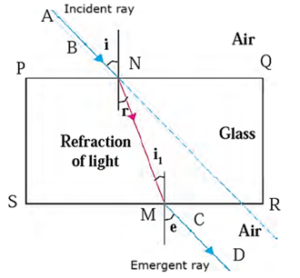
- For the first refraction the angle of incidence is i while for the second it is i1. The angle of refraction at N is r. Note that i1 = r.
- In the second refraction, the angle of refraction is e which is equal to i.
- On both parallel sides PQ and RS of the glass slab, the change in direction of light ray is equal but in opposite directions. Thus, the light ray MD emerging from the glass slab is parallel to the incident ray AN on the side PQ of the slab.
- But the emergent ray is somewhat displaced with respect to the incident ray.
Laws of refraction of light:
- (i) The incident ray and the refracted ray are on the opposite sides of the normal to the surface at the point of incidence and all the three, i.e. the incident ray, the refracted ray and the normal are in the same plane.
- (ii) For a given pair of media, the ratio of the sine of the angle of incidence (sin i) to the sine of the angle of refraction (sin r) is constant (Snell's law).
\(\frac{sin\,i}{sin\,r}\) = Constant = n
- This constant is called the refractive index of the second medium with respect to the first medium. Here, i is the angle of incidence and r is the angle of refraction.
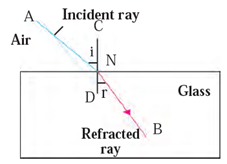
Refractive index :
(i) If i is the angle of incidence and r is the angle of refraction, then \(\frac{sin\,i}{sin\,r}\) = constant (Snell’s law)
This constant is called the refractive index of the second medium with respect to the first medium, and is denoted by 2n1. Thus, 2n1= \(\frac{sin\,i}{sin\,r}\)
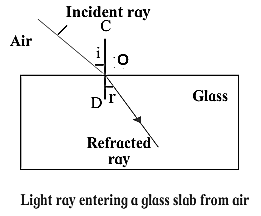
(ii) Also, if v1, is (the magnitude of) the velocity of light in the first medium and v2 is (the magnitude of) the velocity of light in the second medium then
Refractive index 2n1 = \(\frac{\text{velocity of light in medium 1}(v_1)}{\text{velocity of light in medium 2}(v_2)}\)
Similarly, the refractive index of the first medium with respect to the second medium is given by 1n2 = \(\frac{v_2}{v_1}\)
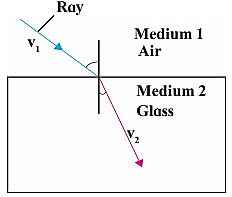
If the first medium is vacuum, 2n1is considered with respect to vacuum. It is called the absolute refractive index of the medium 2 and is denoted by n.
Remember :
- Refractive index depends on the velocity of light in the medium.
- The change in the direction of a light ray while entering different media is different. It is related to the refractive index of the medium.
- The value of the refractive index is different for different media and also for light of different colours for the same medium.
- The refractive indices of some substances with respect to vacuum are given in the table.
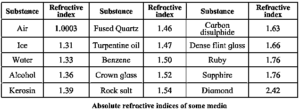
- The absolute refractive index of air is 1.0003. This shows that for almost all practical purposes, the speed of light in air is very nearly the same as that in vacuum.
Absolute refractive index : The refractive index of a medium with respect to vacuum is called its absolute refractive index.
Behaviour of a ray of light in refraction :
(i) When a light ray passes from a rarer medium to a denser a medium, it bends towards the normal at the point of incidence.
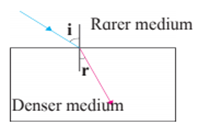
Here, i is greater than r, and 2n1 is greater than 1. The greater the value of 2n1 the greater is the bending towards the normal.
(ii) When a light ray passes from a denser medium to a rarer medium, it bends away from the normal at the point of incidence.
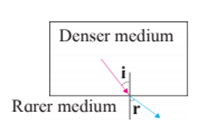
Here, r is greater than i, and 2n1 is less than 1. The greater the value of 2n1 the less is the bending away from the normal.
(iii) When a light ray is incident normally at the boundary between two media, it does not change its direction and hence does not get refracted.
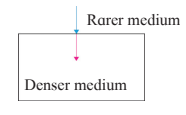
- If a ray of light is incident normal to the interface between any two media (whether passing from an optically rarer medium to an optically denser medium or from an optically denser medium to an optically rarer medium), the angle of incidence is zero and so also the angle of refraction (i = r = 0). Here, the light goes ahead in the same direction.
Difference between the Refraction of light passing through a glass slab and Refraction of light passing through transparent plastic slab :
- Similarity : The emergent ray is parallel to the incident ray, but it is displaced slightly sideways.
- Difference : For a given angle of incidence, the extent of refraction (bending) is different (in general, less) for a transparent plastic slab relative to the glass slab.
Twinkling of stars :
Local atmospheric conditions affect the refraction of light to some extent.
Examples :
(i) A mirage : Due to the changes in refraction of light, the light rays coming from a distant object appear to be coming from the image of the object inside the ground. This is called a mirage.
- In summer, the sun's heat increases air temperature, creating a layer of hot air with lower density and refractive index. This makes hot air optically rarer than cool air.
- Rapid temperature changes in the vertical direction cause continuous refraction of light, resulting in an inverted image below an object's true position and downward towards the surface.
- Some rays of light bend back into denser air above. Mirage produces an impression of water near hot ground.
- This phenomenon occurs when the angle of refraction changes continuously in the vertical direction.

(ii) Objects beyond and above a holi fire appear to be shaking : The direction of light rays coming from objects beyond the holi fire changes due to changing refractive index above the fire. The air near the holi flames is hot and hence rarer than the air above it. Thus, the objects appear to be moving.
Twinkling of a star and atmospheric refraction :
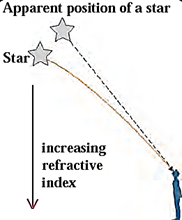
- As a star is far away from the earth, it appears as a point source of light.
- When Starlight enters the earth’s atmosphere, it undergoes refraction continuously in the medium with gradually varying refractive index.
- The bending of starlight occurs towards the normal as it passes from the optically rarer part of the medium to the optically denser part.
- Hence, when a star is observed near the horizon, its apparent position is slightly higher than the actual position. Further, the apparent position varies with time as the medium is not stationary.
- Also, there is fluctuation in the brightness of a star when observed from the earth. This is called twinkling of a star.
Planets do not twinkle : The planets are relatively closer to the earth. Hence they appear as a collection of a large number of point sources of light. The net fluctuation in the brightness of a planet, therefore, turns out to be zero. Also, there is no change in the average position of a planet. Hence, planets do not twinkle.
Advanced sunrise and delayed sunset :
Advanced sunrise and delayed sunset :
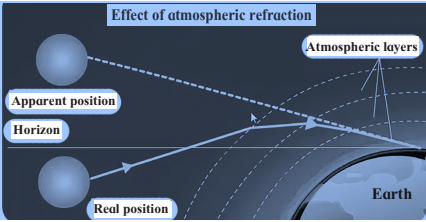
- The sunrise and sunset are two significant events in Earth's solar cycle. The advanced sunrise occurs due to atmospheric refraction of sunlight, which causes the sun to appear slightly higher than its actual position, allowing the observer to see it two minutes before the sun reaches the horizon. This refraction occurs due to a gradual variation in the atmosphere's refractive index, resulting in the sun's apparent position slightly higher than its actual position.
- The delayed sunset occurs when the sun disappears below the horizon, causing the observer to continue seeing the setting sun for two minutes, delaying the sunset.
- This process increases the day's duration by four minutes.
Dispersion of light :
Dispersion of light : The process of separation of light into its component colours while passing through a medium is called dispersion of light.
- The band of coloured components of a light beam is called its spectrum.
- The formation of a rainbow is due to refraction, dispersion, internal reflection and again refraction of sunlight by water droplets under appropriate conditions.
- Our eyes are sensitive to electromagnetic radiation of wavelength in the range 400 nm to 700 nm. [1nm=10-9m; nm= nanometer]
- Wavelength of red light is close to 700 nm and that of violet light is close to 400 nm.
- Dispersion takes place because the refractive index of a material such as glass or water, is different for different colours. It is maximum for violet colour and minimum for red colour.
- Hence, in the spectrum of white light (sunlight) obtained with a prism, violet light is deviated the most while red light is deviated the least. The deviation of light corresponding to other colours lies in between.
Dispersion of white light when it passes through a glass prism :
Dispersion of white light when it passes through a glass prism :
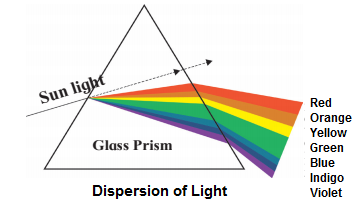
- When light is incident on a prism, it undergoes two refractions, traveling from air to glass and then back to air.
- The triangular prism's base bends the emergent rays, causing them to deviate.
- The refractive index of glass varies for different colors, causing rays to deviate to different extents.
- White light, a mixture of seven colors, produces a spectrum of seven colors when incident on a prism.
- Violet light is deviated the most, while red light is the least. The deviation of rays corresponding to other colors is intermediate, resulting in light dispersion when passing through a glass prism.
Partial and total internal reflection :
Partial reflection : When light enters a rarer medium from a denser medium, it gets partially reflected i.e. part of the light gets reflected and comes back into the denser medium as per laws of reflection. This is called partial reflection. The rest of the light gets refracted and goes into the rarer medium.
Internal reflection of light : When light travels from a denser medium to a rarer medium, if the angle of incidence is greater than the critical angle, there is no refraction of light and all the light is reflected in the denser medium. This is called total internal reflection of light.
Critical angle : When light travels from a denser medium to a rarer medium, the angle of incidence for which the angle of refraction becomes 90°, is called the critical
angle.
Below Figure shows passage of light from water (denser medium) to air (rarer medium).
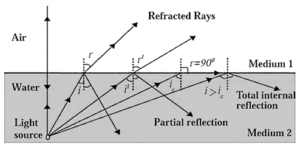
The ray of light incident at the boundary separating the two media bends away from the normal on refraction. Here, the angle of refraction r, is greater than the angle of incidence i.
Now anw = < 1. Here, anw is the refractive index of air with respect to water.
As anw is constant, r increases as i increases. For r = 90°, the ray travels along the
boundary. If i is increased further, as r cannot be greater than 90°, light does not enter air.
There is no refraction of light and all the light enters water on reflection. This is called total internal reflection.
For r = 90°, anw = = sin i (∴ sin 900 = 1). This angle i is called the critical angle.
Formation of rainbow :
Formation of rainbow :
(i) The formation of a rainbow in the sky is a combined result of refraction, dispersion, internal reflection and again refraction of sunlight by water droplets present in the atmosphere after it has rained.

(ii) The sunlight is a mixture of seven colours : violet, indigo, blue, green, yellow, orange and red. After it has stopped raining, the atmosphere contains a large number of water droplets. When sunlight is incident on a water droplet, there is
- refraction and dispersion of light as it passes from air to water
- internal reflection of light inside the droplet and
- refraction of light as it passes from water to air.
(iii) The refractive index of water varies for different colors, with violet having the highest and red having the lowest, causing light dispersion.
(iv) Water droplets act like tiny prisms, producing a rainbow with red at the outer side and violet at the inner side, with the remaining five colors lying between.
The rainbow is visible when the sun is behind the observer and water droplets are in front.
Useful links :
| Main Page : - Maharashtra Board Class 10 Science & Technology Part-1,Part-2 - All chapters notes, solutions, videos, test, pdf.
Books : MSBSHSE -Class 10th Science Text Books – Chapter wise PDF for download Previous Chapter : Chapter-5-Heat - Online Notes Next Chapter :Chapter-7-Lenses - Online Notes |